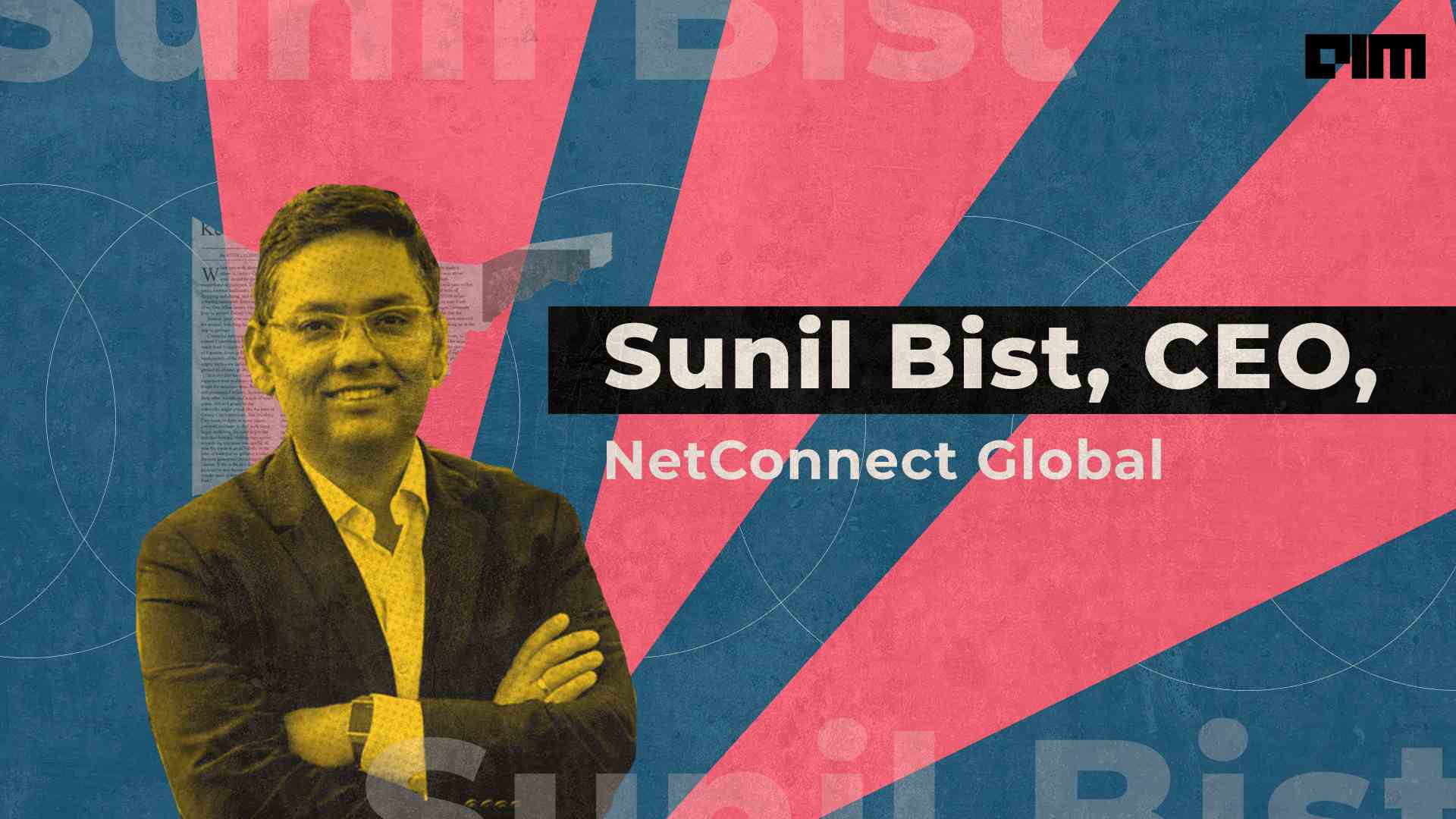Founded in 1997, NetConnect Global is a leading technology solutions and services organisation. The company has been a major proponent in the digital transformation of some of the major firms globally. NCG’s IT professional services and managed services are backed by innovative and forward-thinking tech teams. Analytics India Magazine caught up with CEO Sunil Bist to understand the company’s journey and his insights on the digital transformation wave that has gripped the world.
Edited excerpts from the interview:
AIM: What are the major services offered by NCG?
Sunil Bist: NCG is a technology solutions and services organisation. We offer the following services and solutions.
- Technology Services: Managed Services, Professional Services, Implementation Services
- Technology Solutions as follows:
Internet of Things Solutions – Tondo & RealiteQ
Our IoT solutions are greatly emphasised in Big Data, AI, ML, Cloud, Edge Computing, and Analytics. These solutions are offered to digitally transform businesses that require technology to make informed & data-driven decisions. They came to a package of IoT Hardware and software and were provided in DaaS (Device as a Service) & SaaS (Software as a Service) business models. We bring Hi-Tech, Secure, Tested, and Reliable technologies worldwide to change India’s public infrastructures, utilities, and industrial operations landscape. The functions of these sectors can be transformed from a legacy to a digital-first business using these technologies for a cost-effective, intelligent, sustainable, and efficient company.
Digital Solutions – Asset360, Ops360, Bill360
Our digital solutions are cloud-driven, single-glass of pane solutions for digital transformation in an enterprise. The solutions are SaaS-enabled, mobile, and web-based digital solutions. As a business, these solutions focus on managing these four critical business pillars, i.e., Assets, Operations Workforce, Billing & Revenue, and Customer Experience digitally. Enterprises have an advanced infrastructure and various solutions working in silos. Our aim with this offering is to provide a digital platform to manage all with one platform and use integrated data from all critical business pillars to create a data-driven system.
AIM: What is the current scenario of enterprise digital transformation in India?
Sunil Bist: For a few years, India has been on a digital-first trajectory. With the revolutionisation of the telecom industry, India has one of the largest and fastest-growing consumer bases for internet services. A lot of enterprises worldwide saw this opportunity and grabbed it. Today, these enterprises have become world leaders.
The COVID-19 pandemic exposed the world to the horrors of stagnation. However, slowly everyone started to adapt to the new normal. Enterprises were no exception; every organisation had to adapt to recent changes, be it large or small businesses. In India, consumer product companies, telecommunications, and financial services have been the most proactive.
Along with education and healthcare, they have been quick adopters of the process. Financial services, education, healthcare, and FMCG companies have been rapid adopters. Automotive, logistics, travel, and hospitality have also taken to digitalisation at their paces. Observing the digital transformation trends of various enterprises, it is evident that many enterprises react to pressure or digitise processes without adequate analysis. Some of the IT companies have taken their time to transform completely after trying out solutions internally first. Construction and infrastructure, insurance, and energy have not performed well on both analytics and digitisation efforts.
Digital transformation should be at the forefront of every enterprise. We believe the future of India’s digital transformation market looks promising for the rising number of micro, small and medium enterprises (MSME) in the country. Increasing MSMEs in India would provide opportunities for players in the digital transformation market. Successful implementation of major digital transformation trends like connecting and personalising the customer experience, unlocking and analysing data-driven business, maximising the value of AI and machine learning, developing a multi-cloud strategy, and fueling business performance with APIs will be a significant determinant of the future of digital transformation in India
AIM: Speaking of digital transformation, one can not undermine the importance of having a robust cloud infrastructure. In this context, what do you think would benefit companies more — public or private clouds?
Sunil Bist: Many businesses prefer private cloud over public because it is a more convenient (or the only) way to meet regulatory compliance requirements. Others prefer private cloud because their workloads involve confidential documents, intellectual property, personally identifiable information (PII), medical records, financial data, or other sensitive information.
When a company builds a private cloud architecture based on cloud-native principles, it enhances the flexibility to quickly move workloads to the public cloud in a hybrid cloud (see below) environment whenever they are ready. The public cloud is a multi-tenant environment in which all public cloud customers share the data center infrastructure of the cloud provider. Customers in the top public clouds—Amazon Web Services (AWS), Google Cloud, IBM Cloud, Microsoft Azure, and Oracle Cloud—can number millions.
The global public cloud computing market has snowballed in recent years, and analysts predict that this trend will continue; Gartner predicts that global public cloud revenues will exceed USD 330 billion by the end of 2022.
Many businesses are migrating portions of their computing infrastructure to the public cloud because public cloud services are elastic and scalable, allowing them to adapt to changing workload demands. Others are drawn to the promise of increased efficiency and fewer wasted resources because customers only pay for what they use. Finally, others want to save money on hardware and on-premises infrastructure.
Depending upon goals, budget, and company size, private clouds are used by larger businesses with complex requirements. However, if the company does not have the technical expertise to work with a private cloud alone, they can opt for fully managed third-party providers. In addition, smaller businesses with no specific needs can benefit greatly from the public cloud’s dependability, simplicity, and scalability.
AIM: Companies like Microsoft and Google are increasing their cloud business in India. What is your take on this trend? What are the factors behind such growth?
Sunil Bist: Yes, companies like Microsoft, Google, and a few other giants are increasing their cloud business in India, significantly increasing the rate of cloud services adoption. Analysing the recent growth of cloud business in India, the COVID-19 pandemic might appear to be the most significant factor behind it, which indeed has been a driving force. Still, numerous other factors have paved the way for this accelerated adoption of cloud services.
We believe cloud services are attractive to organisations of all sizes across sectors because of their promising higher performance, lower costs, easier integration, and smoother cloud migration. IT enterprises have unsurprisingly been the first to ride the wave of cloud services.
Cloud services help enterprises achieve reduced CAPEX and OPEX to deliver business services. Leading and competing organisations aim to create effortless, multi experiences with technology for organisations and customers, and cloud services facilitate the same by making transformation and optimisation across different processes uncomplicated and improving the quality of the app development process.
Cloud services lure in the Indian IT enterprises also because of the flexibility and scalability they offer without investing in upfront IT infrastructure. There are four types of cloud deployment models based on the implementation type, hosting type, and who has access to it: public, private, hybrid, and community. This range of deployment models has been instrumental in making cloud services suitable to a range of users.
While the many advantages of cloud services should have driven the cloud adoption process in India, the COVID-19 pandemic certainly had a considerable part to play. The revenue of the Indian Public Cloud Services Market was $3.6 billion in 2020 and is expected to reach $9.5 billion by 2025, growing at a CAGR of 21.5 per cent. To mitigate the impact of Covid-19, 63% of Indian enterprises increased their investments in hybrid cloud, compared to 46% globally. The role of data centres is indispensable to commercial and governance activities and is expanding more so than ever because of the rapid digital transformation in India post-pandemic.
AIM: What kind of policy-level change can help rapid digitalisation in India’s context?
Sunil Bist: Digitalisation plays a significant role in changing society and business due to digital technologies in the organisation or operating environment. With the population and need for development, India is a perfect place for rapid digitalisation.
India being a developing nation, it has always been a challenge to navigate the information and accessibility due to the stark economic gap between communities. Taking an example from the pandemic, when everyone around the world was ready to welcome the new normal, most of the population in India suffered due to the lack of essential technological resources. The state of access and technological literacy in India needs increased focus on policies to achieve rapid digital transformation. With an increased proportion of our population equipped with technical resources and literacy, a larger demographic will support the rapid digitalisation.
For rapid digitalisation, one of the most critically needed strategic rearrangements in the policies can involve increased investment in digital infrastructure and R&D in digitalisation. Increased investment would mean more focus on advancing and upgrading technologies that can become the backbone of digitalisation in India. This Government can subsidise the resources used in building a sounder digital infrastructure. Also, increased grants to R&D in the field of digitalisation would boost the development in digitalisation.
In India, where the population is still very apprehensive about their data security, digitalisation in sectors, especially banking and finance, is met with a lot of speculation. There need to be some measures taken proactively to assure the general population and the most prominent players in the digital market of the security that the digitalisation process offers. Shifting to digital platforms and businesses requires a behavioural change that can only be achieved with a demonstrated performance delivered with trust and met with customer satisfaction. Breach of privacy and data security is of grave concern when discussing what they can cost if compromised. The Government should place stringent policies to ensure the confidentiality of processes and protection of data and privacy. This can be encouraged through the widespread adoption of new technologies which have easy-to-use authentication solutions.
Moreover, there certainly have been many policies in place in the past, but plagues like corruption and ignorance are the biggest hurdles in successfully implementing these policies. Therefore, one of the essential things that policymakers need to work on is the strategies to oil the mechanism of implementing these policies.
AIM: Tell us about NCG’s involvement in SCADA and Smart city.
Sunil Bist: RealiteQ as a solution is the 4th generation of SCADA technology. This web-Based SCADA System comes as a holistic solution for various applications across industries and smart cities. The primary element of the system is to remotely control and monitor. The legacy SCADA system allows you only to monitor your sites from the plant location; Web-SCADA brings it all to your mobile phones and laptops.
A smart city consists of various elements, and these are our primary focus areas for smart cities development elements:
– Utilities – Gas, water, electricity, renewable sources of energy
– Public Infrastructure – Street lights, buildings, pedestrian infrastructure, tolls, roads, traffic signals, etc.
We focus on these elements as they are the ones that consume all-natural and renewable resources. Our solutions are made for smart cities – with one agenda – To control, monitor, and conserve. These solutions focus on connecting things and making an Internet of Things network for a connected city that is easy to operate, maintain, and upgrade.
AIM: What is the state of the IoT industry in India? What can be done to improve it?
Sunil Bist: IT companies and the Government have been two major players in the promotion of IoT technologies. In 2015, the Government of India took some initiatives towards IoT. The Government has launched several research and development projects for assisting technologies. The priority is to establish 100 smart cities across the country, followed by the automation of several industries such as energy, health, and disaster management through remotely connected devices.
The Government also launched campaigns like Make in India and Digital India, further reinstating the digital transformation agenda. Big tech giants to partner with the Indian Government for these campaigns. But even with all the efforts, the rate at which India was adapting to digital transformation was slow. The government-backed initiatives to strengthen IoT’s growth plan include developing 100 innovative city projects and a $100 billion investment in the telecommunications sector by 2022.
Even after the acceleration that the pandemic provided to the development of IoT technologies, there remain areas where improvements can be made:
- Changing the mindset of people that machines will take their jobs away because it is only then a core infrastructure for IoT supply and demand can be established.
- With IoT technologies coming to the forefront, one area that needs to be more strengthened is data security and privacy.
- Training more people to work with IoT-based technology and training those who can develop and enhance these technologies so that with the rapid expansion in this sector, the supply does not fall short.




















































































